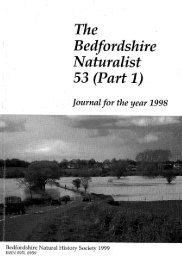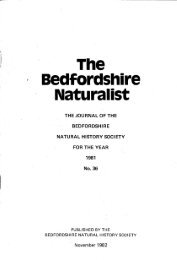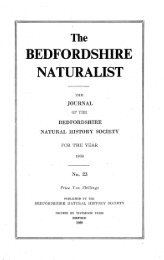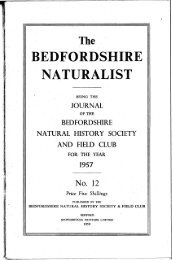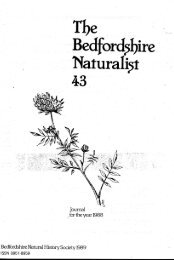1997 No. 52 Part 1 - Bedfordshire Natural History Society
1997 No. 52 Part 1 - Bedfordshire Natural History Society
1997 No. 52 Part 1 - Bedfordshire Natural History Society
You also want an ePaper? Increase the reach of your titles
YUMPU automatically turns print PDFs into web optimized ePapers that Google loves.
<strong>Bedfordshire</strong> <strong>Natural</strong>ist for <strong>1997</strong>, <strong>No</strong>. <strong>52</strong> (<strong>Part</strong> 1) (1998)<br />
each visit it became necessary to dig away an ever-increasing quantity ofGault, particularly<br />
as the year progressed, creep and slumping ofthe clays becoming a serious problem.<br />
As in most sqft sedimentary rocks the majority offosslls in the clays are. crushed by<br />
pressure and are uncollectable except as impressions in matrix. "Solid" preservation of<br />
fossils, particularly· ammonites in the junction beds, are in the form ofphosphatic casts<br />
and represent a small proportion ofthe fauna. Many are imperfectly preserved, being<br />
fragmentary and forming part ofa gritty nodule; some are part-phosphatised with one<br />
side only being preserved uncrushed. Many specimens occurring in the junction beds<br />
consist ofbody-chambers only, the inner whorls and phragmocones being represented<br />
by impressions or crushed remnants in the clay. An example ofsuch body-chamber<br />
preservation is illustrated in the 1996 Report (Fig. 1, a - c), and species with<br />
compressed whorls such as Cleoniceras and Beudanticeras appear to be particularly<br />
vulnerable in this respect. Casey (1960-1980, p xxxiv) describes a method by which<br />
the complete form ofa part-phosphatised ammonite can be reconstituted, but his<br />
examples refer to those in relatively hard rocks including phosphorite.The Recorder<br />
has had no success in his attempts to reconstitute part-phosphatised specimens from the<br />
Leighton Buzzard Albian clays.<br />
The rare ammonites from Beds 3(i) and 3(ii) ofthe temporary section in Chamberlain's<br />
Barn pit, and subsequently presented to the <strong>Natural</strong> <strong>History</strong> Museum are:<br />
(a) Cleoniceras (Cleoniceras) aff. seunesi Bonarelli (BMNH- CA 1688)<br />
Cleoniceras (Cleoniceras) Spa (BMNH CA 1686)<br />
(b) Cleoniceras (Neosaynella) sublaeve (Casey) (BMNH CA 1685)<br />
(c) Cleoniceras (Cleoniceras) dimorphum Casey (BMNH CA 1682)<br />
(d) Cleoniceras (Cleoniceras) seunesi Bonarelli (BMNH CA 1683)<br />
Cleoniceras (Cleoniceras)jloridum Casey (BMNH CA 307)<br />
Protanisoceras (Protanisoceras) acteon (d'Orbigny) (BMNH CA 1687)<br />
Protanisoceras (Protanisoceras) blancheti (Pictet & Campiche) (BMNH CA 1689)<br />
Single specimens only were obtained ofthese species as listed, the <strong>Natural</strong> <strong>History</strong><br />
Museum Register numbers being shown in parentheses. It is ofparticular interest that<br />
hitherto the distribution of (a), (b), (c) and (d) in the OK has not included the<br />
Leighton Buzzard district, the distribution of (a) and (d) being Kent and Surrey; (b)<br />
Kent, Surrey and the Isle ofWight; and (c) Kent (Casey 1960-1980,553-574).<br />
In addition to the listed species, three small well preserved specimens of Beudanticeras<br />
arduennense Breistroffer and one Douvilleiceras orbignyi Hyatt were collected during the<br />
year from this same temporary section, the first record ofthese two species made by<br />
the writer from the Gault-Woburn Sands junction beds in Chamberlain's Barn.The<br />
importance ofthis assemblage is that in addition to updating the ammonite<br />
biostratigraphy, it provides valuable confirmation ofthe continuing variability ofthe .<br />
Gault-Woburn Sands junction beds in Chamberlain's Barn pit, such variability already<br />
being demonstrated in sections further north and west by, principally, Lamplugh &<br />
Walker (1903); Lamplugh (1922);Wright &Wright (1947); Casey (1961); Owen (1972)<br />
and Smart (1977).<br />
The Gault clays above the junction beds were also investigated regularly, particularly<br />
with regard to vertebrate remains. Such fossils are generally uncommon and no reptilia<br />
were noted. Several teleost and shark teeth were collected from the middle Hoplites<br />
18



